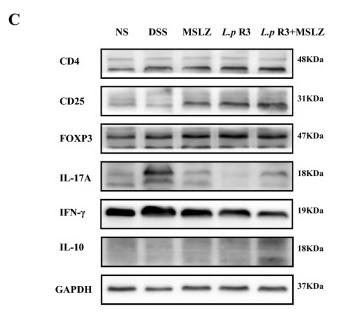IL-2RA/CD25 Antibody - #AF7675
| Product: | IL-2RA/CD25 Antibody |
| Catalog: | AF7675 |
| Description: | Rabbit polyclonal antibody to IL-2RA/CD25 |
| Application: | WB IHC |
| Cited expt.: | WB |
| Reactivity: | Human, Mouse |
| Prediction: | Horse, Dog |
| Mol.Wt.: | 31kDa; 31kD(Calculated). |
| Uniprot: | P01589 |
| RRID: | AB_2844039 |
Related Downloads
Protocols
Product Info
*The optimal dilutions should be determined by the end user. For optimal experimental results, antibody reuse is not recommended.
*Tips:
WB: For western blot detection of denatured protein samples. IHC: For immunohistochemical detection of paraffin sections (IHC-p) or frozen sections (IHC-f) of tissue samples. IF/ICC: For immunofluorescence detection of cell samples. ELISA(peptide): For ELISA detection of antigenic peptide.
Cite Format: Affinity Biosciences Cat# AF7675, RRID:AB_2844039.
Fold/Unfold
Interleukin 2 receptor alpha chain; CD25; CD25 antigen; IDDM10; IL 2 receptor alpha subunit; IL-2 receptor subunit alpha; IL-2-RA; IL-2R subunit alpha; IL2 RA; IL2-RA; IL2R; IL2R, alpha chain; IL2RA; IL2RA_HUMAN; IMD41; Interleukin 2 receptor alpha; Interleukin 2 receptor; Interleukin-2 receptor subunit alpha; p55; t-cell growth factor receptor; TAC; TAC antigen; TCGFR;
Immunogens
A synthesized peptide derived from human IL-2RA/CD25, corresponding to a region within C-terminal amino acids.
- P01589 IL2RA_HUMAN:
- Protein BLAST With
- NCBI/
- ExPASy/
- Uniprot
MDSYLLMWGLLTFIMVPGCQAELCDDDPPEIPHATFKAMAYKEGTMLNCECKRGFRRIKSGSLYMLCTGNSSHSSWDNQCQCTSSATRNTTKQVTPQPEEQKERKTTEMQSPMQPVDQASLPGHCREPPPWENEATERIYHFVVGQMVYYQCVQGYRALHRGPAESVCKMTHGKTRWTQPQLICTGEMETSQFPGEEKPQASPEGRPESETSCLVTTTDFQIQTEMAATMETSIFTTEYQVAVAGCVFLLISVLLLSGLTWQRRQRKSRRTI
Predictions
Score>80(red) has high confidence and is suggested to be used for WB detection. *The prediction model is mainly based on the alignment of immunogen sequences, the results are for reference only, not as the basis of quality assurance.
High(score>80) Medium(80>score>50) Low(score<50) No confidence
Research Backgrounds
Receptor for interleukin-2. The receptor is involved in the regulation of immune tolerance by controlling regulatory T cells (TREGs) activity. TREGs suppress the activation and expansion of autoreactive T-cells.
Membrane>Single-pass type I membrane protein.
Research Fields
· Cellular Processes > Transport and catabolism > Endocytosis. (View pathway)
· Environmental Information Processing > Signaling molecules and interaction > Cytokine-cytokine receptor interaction. (View pathway)
· Environmental Information Processing > Signal transduction > PI3K-Akt signaling pathway. (View pathway)
· Environmental Information Processing > Signal transduction > Jak-STAT signaling pathway. (View pathway)
· Human Diseases > Infectious diseases: Viral > Measles.
· Human Diseases > Infectious diseases: Viral > HTLV-I infection.
· Human Diseases > Cancers: Overview > Pathways in cancer. (View pathway)
· Organismal Systems > Immune system > Hematopoietic cell lineage. (View pathway)
· Organismal Systems > Immune system > Th1 and Th2 cell differentiation. (View pathway)
· Organismal Systems > Immune system > Th17 cell differentiation. (View pathway)
References
Application: WB Species: Mouse Sample: colon tissue
Restrictive clause
Affinity Biosciences tests all products strictly. Citations are provided as a resource for additional applications that have not been validated by Affinity Biosciences. Please choose the appropriate format for each application and consult Materials and Methods sections for additional details about the use of any product in these publications.
For Research Use Only.
Not for use in diagnostic or therapeutic procedures. Not for resale. Not for distribution without written consent. Affinity Biosciences will not be held responsible for patent infringement or other violations that may occur with the use of our products. Affinity Biosciences, Affinity Biosciences Logo and all other trademarks are the property of Affinity Biosciences LTD.
